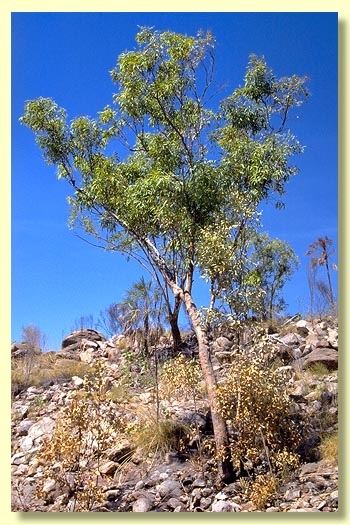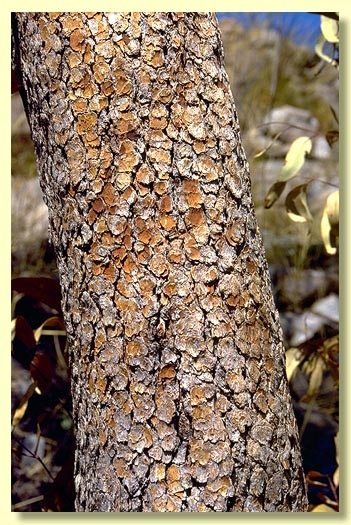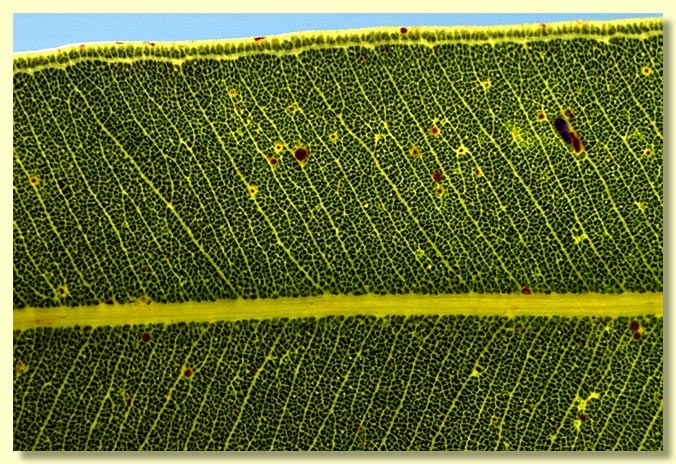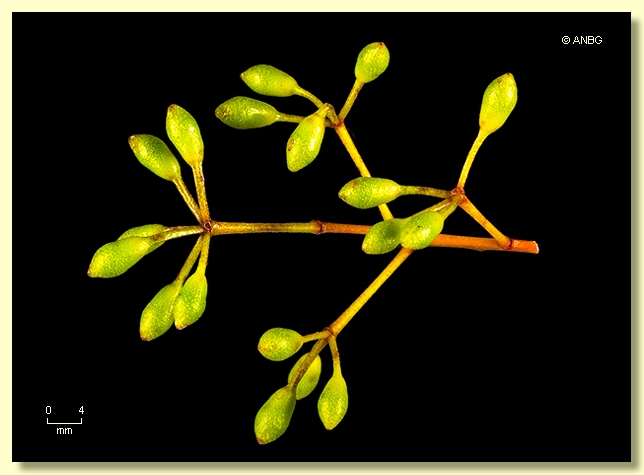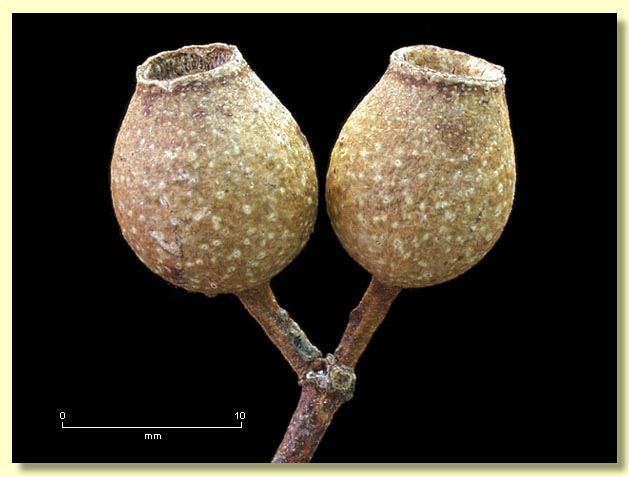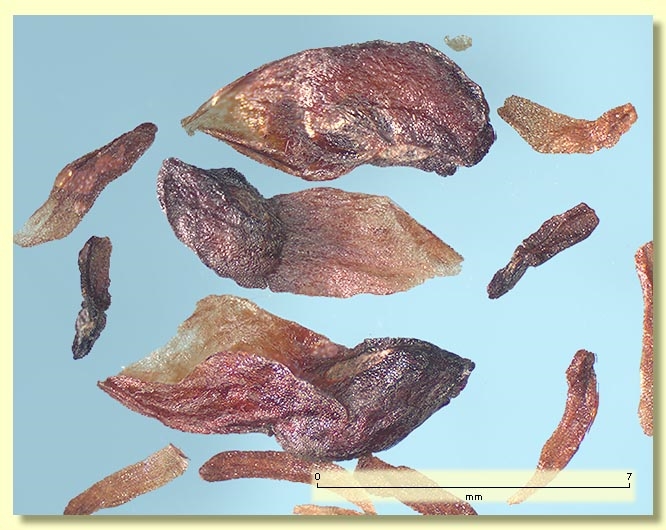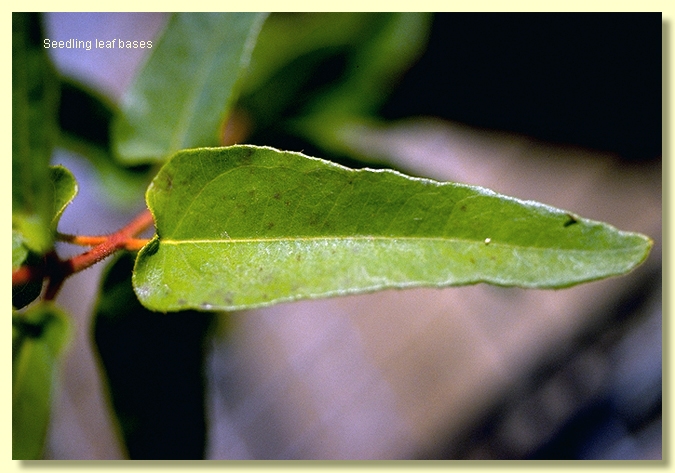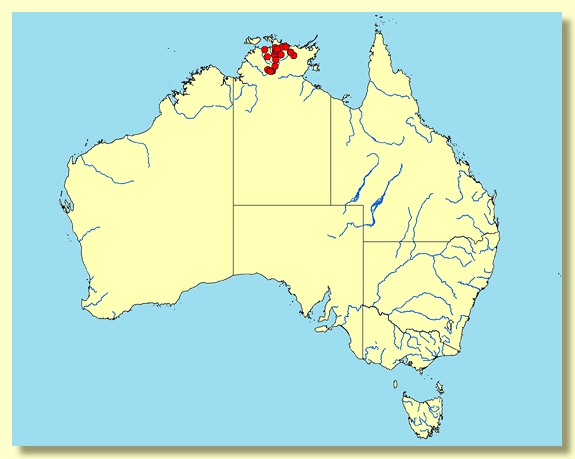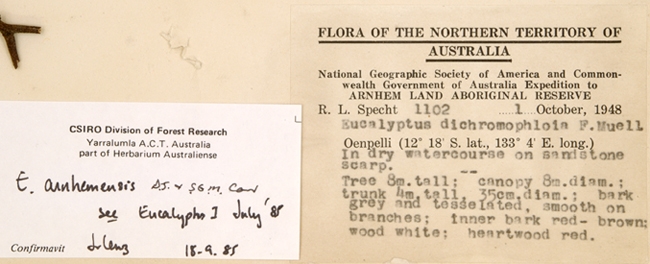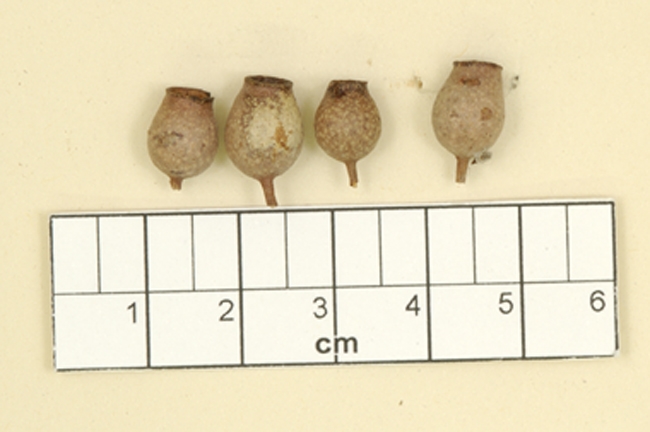Euclid - Online edition
Corymbia arnhemensis
Corymbia | Rufaria
Tree 15 m tall. Forming a lignotuber.
Bark rough, grey to grey-brown, thick and tessellated over at least lower trunk, more usually over entire trunk and sometimes larger branches also; branches smooth, white to pinkish or orange-grey.
Branchlets lack oil glands in the pith; smooth, sometimes glaucous.
Juvenile growth (coppice or field seedlings to 50 cm): stems rounded to square in cross-section, setose with bristle-glands and glaucous (waxy, not with white rubbery cuticle); juvenile leaves always petiolate, opposite to sub-opposite for ca 25–30 nodes, oblong-elliptical to ovate or lanceolate, 3.5–11.5 cm long, 2–4 cm wide, base shallowly lobed to truncate or rounded, green or glaucous, sparsely setose with bristle-glands on both surfaces with a carpet of short white simple hairs on the underside only.
Adult leaves alternate, petioles 0.6–2.5 cm long; blade lanceolate to falcate, 7.5–18 cm long, 0.8–1.8(2.5) cm wide, base tapering to petiole, margin entire, apex pointed, thin-textured, discolorous, dull, green, glabrous, side-veins greater than 45° to midrib (penniveined), reticulation dense to very dense, intramarginal vein very close to edge, oil glands obscure or visible and intersectional.
Inflorescence terminal compound, rhachis branches often whitish, peduncles rounded, slender, 0.4–1.5 cm long, buds 7 per umbel, pedicels slender (0.1–0.9 cm long). Mature buds narrowly pyriform to obovoid (0.4–0.6 cm long, 0.3–0.4 cm wide), glossy, smooth, scar absent (both opercula shed together at flowering), operculum shallowly rounded and often apiculate to conical, stamens inflexed, all fertile, anthers oblong, dorsifixed, versatile, dehiscing by longitudinal slits, style long and straight, stigma blunt and mop-like, locules (3)4, the placentae each with few ovules, not clearly arranged in rows. Flowers white.
Fruit pedicellate (pedicels 0.1–0.9 cm long), urceolate with a short neck that is flared slightly at the rim, 0.8–1.4 cm long, 0.6–1 cm wide, smooth but speckled, disc descending vertically, valves (3)4, enclosed.
Seeds brown, 5–6 mm long, ellipsoidal with terminal wing, hilum ± ventral.
Cultivated seedlings (measured at ca node 10): cotyledons reniform; stems rounded or square in cross-section, prominently setose with bristle-glands; leaves always petiolate, opposite for 16+ nodes, lower leaves small, lanceolate, becoming larger and linear-lanceolate up the stem, 5–10.5 cm long, 0.7–1.7 cm wide, base tapering to truncate or rounded, green, setose on underside, a carpet of short white simple hairs also present on underside.
Flowering has been recorded in February, March, April and November.
Slender tree endemic to the Top End of the Northern Territory, from Jabiluka south to Katherine Gorge, restricted to dissected sandstone plateaus where it favours escarpments and ridges with skeletal soil. Corymbia arnhemensis has thickly tessellated rough bark on the trunk and often on larger branches, dull, discolorous, thin-textured, narrowly lanceolate to falcate leaves in the crown, small glossy buds in terminal inflorescences, small relatively thin-walled urn-shape fruit to 1 cm diameter, and hairy seedling and juvenile growth; the juvenile growth may be glaucous.
C. arnhemensis is likely to be confused with C. oocarpa which is superficially very similar and grows in a similar habitat; in fact the two species may grow together. The crown leaves of C. arnhemensis are distinctly discolorous and dull whereas those of C. oocarpa are usually concolorous or almost so and distinctly glossy; the rough bark of C. oocarpa is thin and confined to the lower trunk whilst C. arnhemensis has much thicker rough bark that usually extends over the whole trunk; buds and fruit of the two species are similar; seedling leaves of C. arnhemensis are much narrower (0.7–1.7 cm wide) whilst those of C. oocarpa are ± ovate (1.5–4 cm wide); juvenile leaves (on field coppice) of C. arnhemensis become ovate and may be glaucous, those of C. oocarpa are also ovate but are not glaucous.
Other bloodwoods with thickly tessellated rough bark, C. polycarpa, C. porrecta and C. ptychocarpa subsp. aptycha, are all lowland species with much larger fruit than C. arnhemensis. Species with thinner but extensive rough bark, C. latifolia, C. foelscheana, with their broader concolorous adult leaves, and C. umbonata with narrow concolorous adult leaves, do not occur on the sandstone of the Arnhem Land plateau. C. nesophila differs in having rough bark to the small branches, adult leaves only slightly discolorous, broader seedling and juvenile leaves, and occurs further north on the coastal fringe and nearby islands when compared with C. arnhemensis.
This taxon was originally described as Eucalyptus arnhemensis and in the classification of the eucalypts by Brooker (2000) was treated thus, being placed in Eucalyptus subgenus Corymbia (the bloodwoods). Hill & Johnson (1995) placed it in genus Corymbia section Rufaria (the bloodwoods), describing two subspecies, viz. C. arnhemensis subsp. arnhemensis and subspecies monticola. We treat subsp. monticola at species level under the name C. serendipita, following Bean (2002). It occurs disjunctly in the Newcastle Range in north-eastern Queensland and differs in having slightly larger fruit on longer pedicels and lacks any glaucescence in juvenile foliage compared to C. arnhemensis.
MORE ABOUT CORYMBIA
MORE ABOUT RED BLOODWOODS
Corymbia arnhemensis: after its area of endemism, the Arnhem Land sandstone plateaus.

